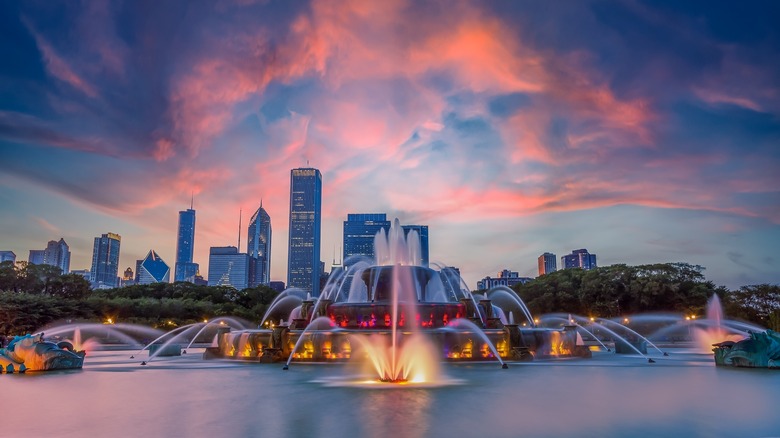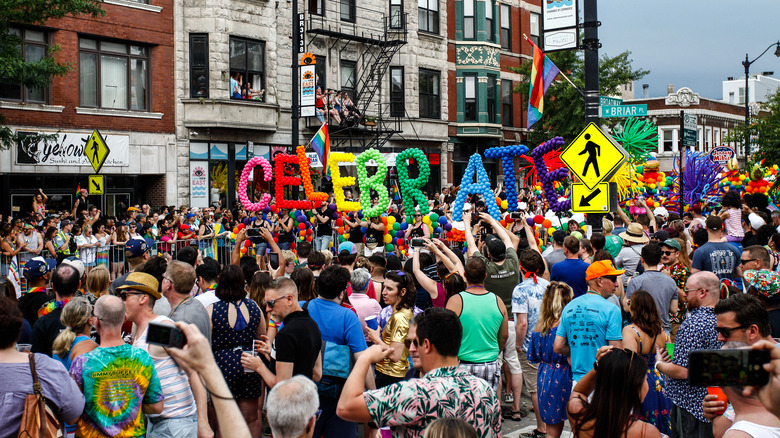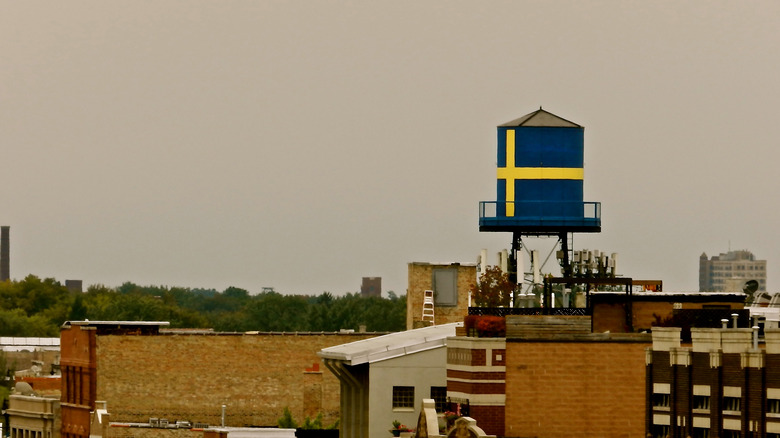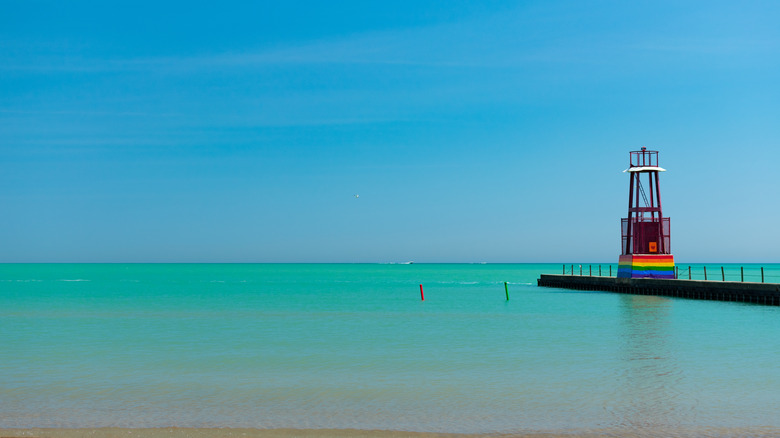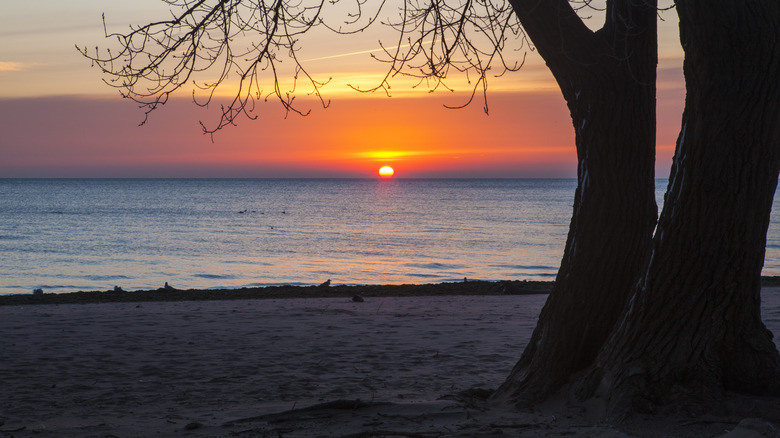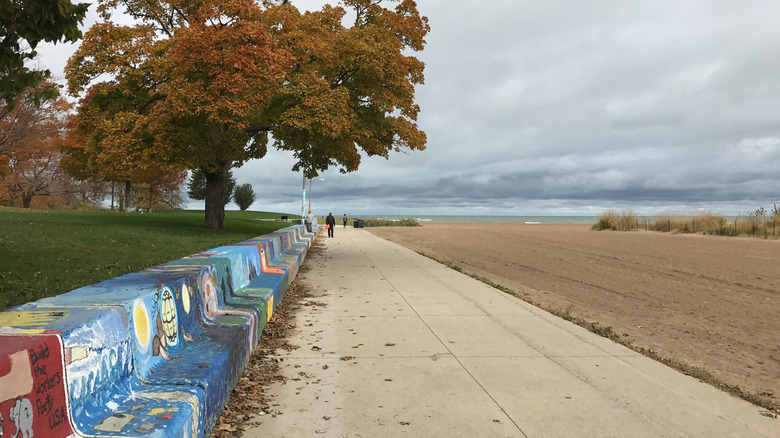The Top 5 Neighborhoods To Live In Chicago If You're LGBTQ+
Among other things, Chicago is renowned for the Cubs, the Lakefront, jazz, and its 1920s gangster legacy. Perhaps less well-known, but no less important, Chicago has earned a proud reputation as an LGBTQ+-friendly city. Gender and women's studies expert Jennie Brier from the University of Illinois Chicago says, "Chicago has always been a queer town, and the historical evidence is pretty clear that queer people live all over the place." Gay-friendly Chicago has a slew of pro-LGBTQ+ neighborhoods. Four are Boystown, Andersonville, Rogers Park, and Pilsen. A fifth key queer gathering place is Kathy Osterman Beach, a part of Lincoln Park, which is also known as the "Gay Beach."
The Chicago Tribune noted some of the city's many gay milestones: It is the home of the nation's initial gay rights organization, The Society for Human Rights. The Second City also has a Gay and Lesbian Hall of Fame, and its current mayor, Lori Lightfoot, is Chicago's first openly gay mayor. As quoted in San Diego Lesbian, Gay, Bisexual, Transgender News, Nerd Wallet ranks the city as the 12th-most LGBTQ+-friendly one in the U.S. Here describes Chicago as fundamentally open-minded and inclusive. It also notes that its gay populace is more significant, less segregated, and includes more groups within its queer community than ever before.
Boystown (also known as Northalsted)
Boystown is high on the list of Chicago's and even the nation's most inclusive LGBTQ+ neighborhoods. It was recognized in 1997 as Chicago's official gay district, making it the first in the U.S. so designated. GOPRIDE reports that 20 rainbow-colored pylons mark the spot, as well as 40 plaques celebrating icons of the movement. More than 30 gay and lesbian businesses line its main commercial area. Since 1970, a year after the seminal Stonewall Inn uprising, Boystown has hosted the annual Chicago Pride Parade that now draws one million spectators. The Northalsted Market Days festival is the Midwest's largest, and the Center on Halsted is the biggest LGBTQ+ community center. Northalsted's Legacy Walk doubles as an outdoor gay history museum.
Boystown's reputation for acceptance and inclusion has been somewhat sullied by Chicago's notoriety for being racially segregated. According to WBEZ, the neighborhood caters predominantly to white, gay, older men. Lesbians and queers of color feel less welcome. It has also evolved into more of an entertainment destination rather than a place to put down roots. Per Block Club Chicago, community and business leaders have opted to change the neighborhood's name to Northalsted (derived from North Halsted Street) to foster inclusion for the entire queer community. The LGBTQ+ hub is now being branded as "Chicago's Proudest Neighborhood."
Andersonville
Now a gayborhood in Chicago's far north side, Andersonville was once the beating heart of Chicago's Swedish population. The Swedish American Museum is still there, and its commercial strip is recognized as a National Historic District for its Swedish heritage and notable architecture.
The Women and Children First bookstore has been a neighborhood magnet for gay women since it opened in 1979. It features 30,000 women-oriented volumes, with a focus on feminist, lesbian, and gay works. It was one of the first women-owned businesses, along with lesbian bars, that soon populated the area. As a result, Andersonville became known as "Girlstown" in ironic contrast to "Boystown." According to Gay Travel, Andersonville has more same-sex married couples than any other zip code in the entire state. However, rising prices have caused many of the female-oriented businesses to close, leading to a changing demographic. Formerly a haven for queer women, Andersonville now has more married couples who are men than lesbians.
TimeOut touts the neighborhood's restaurants and nightlife. Among two local businesses singled out are Wooly Mammoth, a quirky antique shop, and Nobody's Darling, a queer, black, women-owned bar. Another LGBTQ+ establishment is sex shop Early to Bed, whose owner has also opened a venue catering to transgender youth. Andersonville is conveniently situated just a few blocks from Kathy Osterman Beach, Chicago's unofficial gay beach.
Kathy Osterman Beach
Kathy Osterman Beach is a sandy crescent on Lake Michigan and is part of Chicago's Lincoln Park neighborhood. It is a gay entity unto itself. Built on a landfill, it is pleasantly placed in the path of migratory birds. Per City Seeker, the beach derives its name from a revered local alderman who was chief of the Mayor's Office of Special Events and a gay activist as well. It is sometimes also called Hollywood Beach or Ardmore Beach because of the nearby streets. As a gay beach, it is a bit of an anomaly. It is close to residential neighborhoods and easily accessible, unlike many that historically have been hidden away. A light beacon decorated with a rainbow-colored flag points the way to this urban oasis for swimming, rollerblading, and soaking up rays. A volleyball league also adorns its nets with rainbow flags. As is the case with Boystown, Kathy Osterman Beach caters mostly to LGBTQIA whites, and to more men than women.
According to Reader, the predecessor to today's Chicago gay beach was The Belmont Rocks. However, its patrons were decimated by the AIDS epidemic and the beach's popularity waned after the U.S. Army Corps of Engineers bulldozed it. An AIDS Garden is now planned for the site.
Rogers Park
According to Chicago Bar Project, this far north Chicago neighborhood on the lake is slowly morphing into a queer center. Though on the city's outskirts, it is located conveniently close to public transportation. Movoto describes Rogers Park as exceptionally diverse, and a full plate of its nightlife, theaters, galleries, and ethnic cuisine is there for the taking. Residents represent 80 different countries, and the Loyola University campus is an area focal point. A Frank Lloyd Wright house (the Emil Bach house) is another local highlight. Rogers Park is thought to combine a small-town atmosphere with a sophisticated, gay-friendly setting.
There is a substantial gay and lesbian community in the neighborhood. The Glenwood Arts Fest is a vibrant part of the local culture, and there is a flourishing theater scene. Choose Chicago notes that Rogers Park is also the home of the Gerber/Hart Library and Archives, Middle America's most significant circulating collection of LGBTQ+ books and memorabilia. The items include historical material on iconic drag performers and gay sports figures. The nearby Leather Archives and Museum is another gay-themed attraction. Both are close to Touche and Jackhammer, two popular gay venues. Like Pilsen, another pro-gay section of Chicago, Rogers Park is adorned with murals.
Pilsen
Southwest of the city's downtown, the Pilsen neighborhood is Chicago's Latinx core. It is also ascending as an LGBTQ+ stronghold while other sections of the city are pricing people out. Rent describes Pilsen as more laid-back and less flashy than its neighbors in Chicago's other queer areas. Living there is also more economical, and the neighborhood is conveniently located near The Loop and another gay enclave, Wicker Park.
According to Curbed, the area got its name from Czech immigrants from Pilsen who were eventually replaced by Latin and African-Americans. Its Mexican Magnificent Mile shopping district is one of Chicago's most vital. The district has gay nightclubs, and there is an emphasis on art, music, and food. The Pilsen Gay Pride group is devoted to helping its queer residents.
Pilsen's alleys and parking lots are dotted with murals, and this year's National Hispanic American Heritage Month included a walking tour of them. Latina artist Sam Kirk's mural "Fierce" celebrates the LGBTQIA+ community. Kirk, a survivor of a hate crime assault, also worked on another mural in response to the Pulse nightclub massacre. Blueprint draws a straight line from Pilsen's history of welcoming immigrants to its acceptance of gays, many of whom are of Latin American descent. The National Museum of Mexican Art can be found there, and a unique gay Latino teen radio show was also broadcast from the inclusive Pilsen neighborhood.
